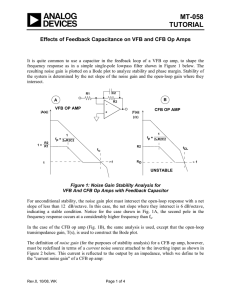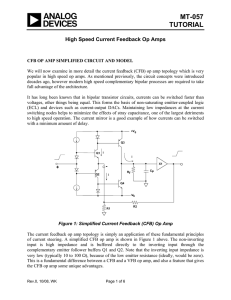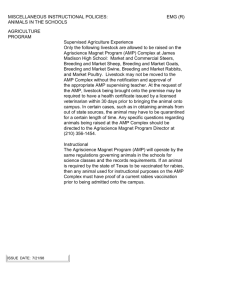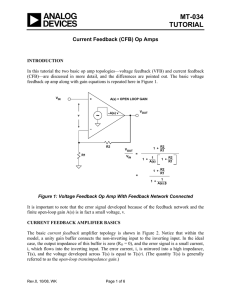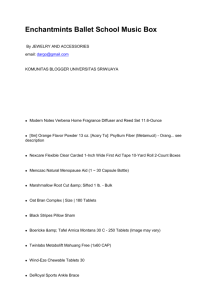MT-059 TUTORIAL
advertisement
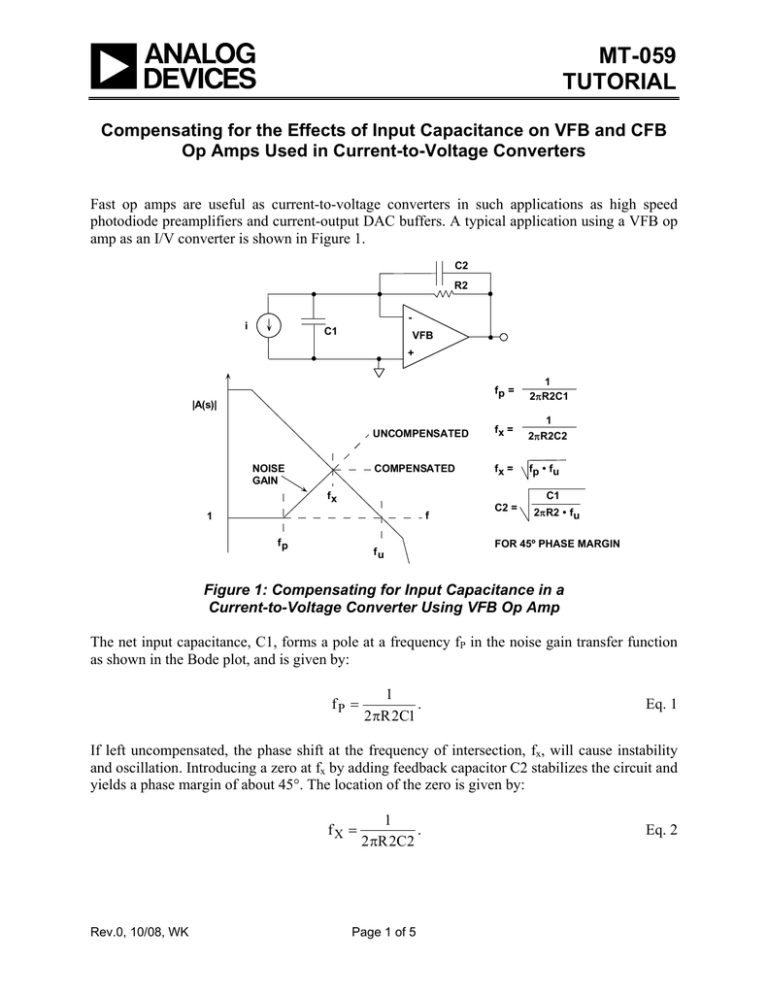
MT-059 TUTORIAL Compensating for the Effects of Input Capacitance on VFB and CFB Op Amps Used in Current-to-Voltage Converters Fast op amps are useful as current-to-voltage converters in such applications as high speed photodiode preamplifiers and current-output DAC buffers. A typical application using a VFB op amp as an I/V converter is shown in Figure 1. C2 R2 - i C1 VFB + fp = 1 2πR2C1 UNCOMPENSATED fx = 1 2πR2C2 COMPENSATED fx = f p • fu |A(s)| NOISE GAIN fx C1 f 1 fp fu C2 = 2πR2 • fu FOR 45º PHASE MARGIN Figure 1: Compensating for Input Capacitance in a Current-to-Voltage Converter Using VFB Op Amp The net input capacitance, C1, forms a pole at a frequency fP in the noise gain transfer function as shown in the Bode plot, and is given by: fP = 1 . 2πR 2C1 Eq. 1 If left uncompensated, the phase shift at the frequency of intersection, fx, will cause instability and oscillation. Introducing a zero at fx by adding feedback capacitor C2 stabilizes the circuit and yields a phase margin of about 45°. The location of the zero is given by: fX = Rev.0, 10/08, WK 1 . 2πR 2C2 Page 1 of 5 Eq. 2 MT-059 Although the addition of C2 actually decreases the pole frequency slightly, this effect is negligible if C2 << C1. The frequency fx is the geometric mean of fp and the unity-gain bandwidth frequency of the op amp, fu, fX = fP ⋅ fu . Eq. 3 Combining Eq. 2 and Eq. 3 and solving for C2 yields: C2 = C1 . 2πR2 ⋅ f u Eq. 4 This value of C2 will yield a phase margin of about 45°. Increasing the capacitor by a factor of 2 increases the phase margin to about 65°. In practice, the optimum value of C2 may be optimized experimentally by varying it slightly, to optimize the output pulse response. A similar analysis can be applied to a CFB op amp as shown in Figure 2 below. In this case, however, the low inverting input impedance, RO, greatly reduces the sensitivity to input capacitance. In fact, an ideal CFB with zero input impedance would be totally insensitive to any amount of input capacitance! C2 R2 i C1 RO + fp = |T(s)| fx = UNCOMPENSATED 1 2πRO||R2•C1 1 1 ≈ 2πROC1 2πR2C2 fx = fp • f CL C2 = RO R2 COMPENSATED fx f R2 fp • C1 2πR2•fCL FOR 45º PHASE MARGIN fCL Figure 2: Current-to-Voltage Converter Using a CFB Op Amp Page 2 of 5 MT-059 The pole caused by C1 occurs at a frequency fP: fP = 1 1 ≈ . 2π( R O || R 2)C1 2πR O C1 Eq. 5 This pole frequency will generally be much higher than the case for a VFB op amp, and the pole can be ignored completely if it occurs at a frequency greater than the closed-loop bandwidth of the op amp. We next introduce a compensating zero at the frequency fx by inserting the capacitor C2: fx = 1 . 2πR 2C2 Eq. 6 As in the case for VFB, fx is the geometric mean of fp and fcl: fx = fP ⋅fu . Eq. 7 Combining Eq. 6 and Eq. 7 and solving for C2 yields: C2 = RO C1 . ⋅ R2 2 πR 2 ⋅ f cl Eq. 8 There is a significant advantage in using a CFB op amp in this configuration as can be seen by comparing Eq. 8 with the similar equation for C2 required for a VFB op amp, Eq. 4. If the unitygain bandwidth product of the VFB is equal to the closed-loop bandwidth of the CFB (at the optimum R2), then the size of the CFB compensation capacitor, C2, is reduced by a factor of √(R2/RO). A comparison in an actual application is shown in Figure 3 below. The full scale output current of the DAC is 4mA, the net capacitance at the inverting input of the op amp is 20 pF, and the feedback resistor is 500 Ω. In the case of the VFB op amp, the pole due to C1 occurs at 16 MHz. A compensating capacitor of 5.6 pF is required for 45° of phase margin, and the signal bandwidth is 57 MHz. Page 3 of 5 MT-059 C2 C2 R2 R2 500Ω 500Ω - 4mA C1 20pF fp = 1 2πR2C1 C1 20pF VFB + - 4mA CFB + fu = 200MHz fp = = 16MHz 1 2πR C1 O C2 = 1.8pF C2 = 5.6pF = 160MHz fx = 176MHz fx = 57MHz Figure 3: CFB Op Amp is Relatively Insensitive to Input Capacitance When Used as an I/V Converter For the CFB op amp, however, because of the low inverting input impedance (RO = 50 Ω), the pole occurs at 160 Mhz, the required compensation capacitor is about 1.8 pF, and the corresponding signal bandwidth is 176 MHz. In practice, the pole frequency is so close to the closed-loop bandwidth of the op amp that it could probably be left uncompensated. It should be noted that a CFB op amp's relative insensitivity to inverting input capacitance is when it is used in the inverting mode. In the non-inverting mode, however, even a few picofarads of stray capacitance on the inverting input can cause significant gain-peaking and potential instability. Another advantage of the low inverting input impedance of the CFB op amp is when it is used as an I/V converter to buffer the output of a high speed current output DAC. When a step function current (or DAC switching glitch) is applied to the inverting input of a VFB op amp, it can produce a large voltage transient until the signal can propagate through the op amp to its output and negative feedback is regained. Back-to-back Schottky diodes are often used to limit this voltage swing as shown in Figure 4 below. These diodes must be low capacitance, small geometry devices because their capacitance adds to the total input capacitance. A CFB op amp, on the other hand, presents a low impedance (RO) to fast switching currents even before the feedback loop is closed, thereby limiting the voltage excursion without the requirement of the external diodes. This greatly improves the settling time of the I/V converter. Page 4 of 5 MT-059 R2 CURRENT OUTPUT DAC - I VFB + *SCHOTTKY CATCH DIODES * NOT REQUIRED FOR CFB OP AMP BECAUSE OF LOW INVERTING INPUT IMPEDANCE Figure 4: Low Inverting Input Impedance of CFB Op Amp Helps Reduce Effects of Fast DAC Transients REFERENCES 1. Hank Zumbahlen, Basic Linear Design, Analog Devices, 2006, ISBN: 0-915550-28-1. Also available as Linear Circuit Design Handbook, Elsevier-Newnes, 2008, ISBN-10: 0750687037, ISBN-13: 9780750687034. Chapter 1. 2. Walter G. Jung, Op Amp Applications, Analog Devices, 2002, ISBN 0-916550-26-5, Also available as Op Amp Applications Handbook, Elsevier/Newnes, 2005, ISBN 0-7506-7844-5. Chapter 1. Copyright 2009, Analog Devices, Inc. All rights reserved. Analog Devices assumes no responsibility for customer product design or the use or application of customers’ products or for any infringements of patents or rights of others which may result from Analog Devices assistance. All trademarks and logos are property of their respective holders. Information furnished by Analog Devices applications and development tools engineers is believed to be accurate and reliable, however no responsibility is assumed by Analog Devices regarding technical accuracy and topicality of the content provided in Analog Devices Tutorials. Page 5 of 5



